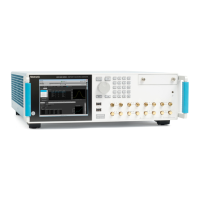Specifications
Table 25: Sync I
n
Characteristics Description
Connector type SMA on rear panel.
Input impeda
nce
500 Ω (AC coupled)
Input ampli
tude
2.5 V
p-p
Max
Frequency
Clock outpu
t ÷ 32.
Table 26: Sync Out
Characteristics Description
Connector type SMA on rear panel.
Output impedance 50 Ω (AC coupled).
Output amplitude 1 V
p-p
, ±20% into 50 Ω.
Frequency
Clock output ÷ 32.
Table 27: Sync Clock Out
Characteristics Description
Connector type SMA on rear panel.
Output impedance 50 Ω (AC coupled).
Output amplitude 0.85 V to 1.25 V
p-p
into 50 Ω.
Frequency
Clock output ÷ 32.
Table 28: Trigger Inputs
Characteristics Description
Number of inputs 2 (A and B)
On 2 and 4 channel instruments, only one trigger is usable for asynchronous triggering. On 8
channel instruments, both triggers can be used.
Connector SMA on rear panel.
Trigger modes
Synchronous and Asynchronous, selectable.
When asynchronous trigger mode is selected, playback starts on the next qualified sample
clock edge. If the trigger pulse has no fixed timing relationship with the sample clock, then
delay jitter will vary by 1 clock cycle.
When synchronous mode is selected, playback starts on the next qualified Sync Clock edge
(Clock ÷ 32). If the trigger pulse is made synchronous with the Sync Out clock, then very low
delay jitter is possible. Using the Sync Out clock provides a larger setup time for the trigger
pulse so that stable triggering can be achieved.
Input impedance
1kΩ or 50 Ω selectable, DC coupled.
Slope / Polarity
Positive or negative, selectable
Input voltage range
1kΩ selected
–10Vto10V.
50 Ω selected
<5V
RMS
18 AWG5200 Series Technical Reference

